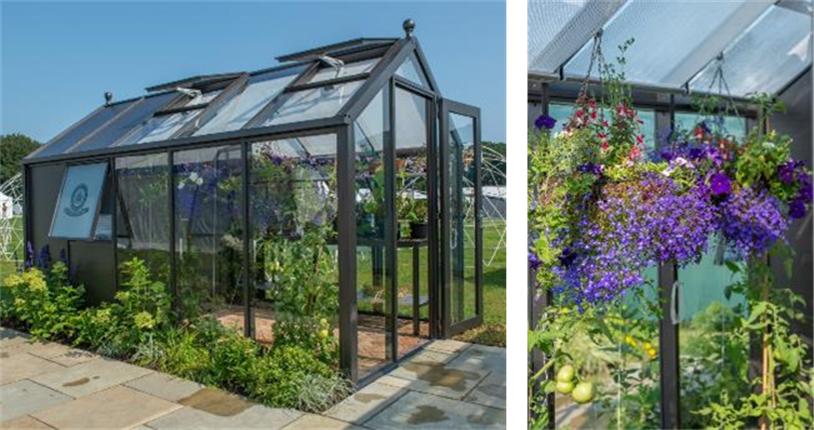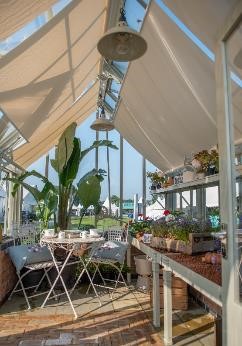
HISTORIC, LANCASHIRE-BASED GREENHOUSE MANUFACTURER TO SHOWCASE OVER 80 YEARS OF HERITAGE & PROUD HISTORY AT RHS CHELSEA FLOWER SHOW
RHS Chelsea Flower Show stand no. 33
English Greenhouse and Glasshouse manufacturer Hartley Botanic is returning to RHS Chelsea Flower Show this year with a stand which celebrates and showcases its business through the decades. The show stand will communicate the Greenhouse manufacturer’s unrivalled heritage and reputation – built over 83 years – with four handmade Hartley Botanic structures, each representing different eras in its trading history. The show stand traces the manufacturer’s incredible legacy using its beautiful handmade structures – from a 1950s vintage Semi-Dodecagon Greenhouse to a modern-day Opus Grand Botanic. The stand has been built and planted by Stewart Landscape Construction with design and styling by Llevelo Garden Design.
Hartley Botanic’s RHS Chelsea Flower Show stand will feature a vintage Semi-Dodecagon Greenhouse (built in the 1950s,) a Hartley 6 Grow and Store (representing the 60s and 70s), a Victorian Terrace (90s) and a Modern Horticulture Opus Grand Botanic (present day). The structures have been dressed to represent the relevant decades using planting schemes, garden tools and accessories typical of each decade. From the 1950s Semi-Dodecagon Greenhouse with its Hydrangeas, Pelargoniums, straw boater, deck chair and sparse accessories (which would have been typical post-war) and the Hartley 6’s beginners’ ‘grow your own’ edibles, Busy Lizzie’s, Hanging baskets and abundance of plastic capturing the 60s and 70s, right up to a modern day Opus Grand Botanic filled with herbs, a large citrus tree, a palm and trendy hanging houseplants planted with peat free compost in biodegradable pots, the show stand is truly a journey through Hartley Botanic’s legacy and the history of Greenhouse gardening as a whole.
Hartley Botanic was founded in 1938 by brothers Vincent (RHS fellow) and Norman Hartley following their ground-breaking aluminium Greenhouse design, the first time (to our knowledge) aluminium had been used in Greenhouse construction and marking a huge improvement on its wood and wrought iron Victorian forerunners. The English manufacturer is an authority on Greenhouse design and use over the decades, having been making its beautiful and elegant handmade, made-to-order horticultural buildings for over 83 years from its original factory at the base of the dramatic Pennines’ Chew Valley in Greenfield, Lancashire. It has become synonymous for crafting the finest Greenhouses money can buy through the very highest standards of hard-won experience, craftsmanship and service. A hugely respected brand within the horticultural world, it is the manufacturer of choice for leading organisations, institutions and designers with Hartley Botanic structures commissioned by the RHS, the National Trust, Kew Gardens, Glasgow Botanic Gardens, Massachusetts Horticultural Society, Oxford Botanical Gardens, Le Manoir aux Quat’Saisons, Blenheim Palace, The Lingholm Estate and Hampton Court Palace…to name a few. Its entire product range is endorsed by the Royal Horticultural Society.
In April of this year, the manufacturer was awarded a prestigious Queen’s Award for Enterprise in the international trade category, thanks to the significant growth of its international business – driven largely by demand for its beautiful, handmade English Glasshouses and Greenhouses from customers in the United States.
Tom Barry, CEO of Hartley Botanic said; “Hartley Botanic has an unrivalled history when it comes to English Glasshouse and Greenhouse manufacture and generations of customers have put their trust in the hands of our expert, time served, highly skilled craftsmen. We wanted the stand to communicate this. As a historic business, we are in a unique position to be able to provide an overview of the way Greenhouse design and use has developed and changed over the decades. From the Semi-Dodecagon styles of the post war years, to the small highly practical, suburban Greenhouses of the 1960s and 1970s. It is also interesting to see some of the historical trends coming back into fashion today. As in the 1970’s, we are again seeing a resurgence in city dwellers buying smaller models so they can try growing their own for the first time – only this time, as a reaction to lockdown or another way to address sustainability concerns, rather than an attempt to live ‘the good life’.”
Hartley Botanic through the decades (from modern day to the 1950s) – details of the Greenhouses on the stand:
- Modern Horticulture Opus Grand Botanic – Era: modern day

The handmade Opus Grand Botanic powder-coated in black will be filled with herbs, a tender large citrus tree, ornamental palm, succulents and hanging plants are draped over shelves – all very popular plant choices for today’s modern Greenhouse grower. Greenhouse accessories have also been selected to reflect our increasing awareness and commitment to being more sustainable in all areas of our lives – including in our Greenhouses. Plants will be potted with peat-free compost and gardening tools and pots made of bamboo and wooden fibre will be featured. Bee bricks will also feature in the Greenhouse’s brick base, providing a manmade nesting site, to support the declining solitary bee population.Hartley Botanic’s Opus Grand Botanic, the largest Glasshouse on the stand, will represent modern day Greenhouse design. The Opus Grand Botanic is the newest addition to the manufacturer’s Modern Horticulture range, contemporary Glasshouses in demand amongst gardeners due to its modern look, clean lines and concealed engineering. The structure represents the latest in Greenhouse and Glasshouse design which is being led by gardeners interested in a more architectural look and in a design-led approach to gardening in general.
- Victorian Terrace – Era: 1990s
Owning a Greenhouse which had a Victorian style was popular in the 90s, as was using the space to grow and display colourful and exotic species. The Victorian Terrace on the stand will be filled with colourful 90s blooms – including Orchids, Begonias, Alyssum and a potted Fig tree. Elegant garden furniture such as a wrought iron table and chairs dressed for tea and stylish accessories would have completed the period aesthetic. Bee bricks have also been incorporated into the Greenhouse’s brick wall base.The Victorian Terrace on the stand will represent the 1990s in Hartley Botanic’s history. The manufacturer launched its Victorian range in July 1996 and it has subsequently become its most popular and remains so today. Hartley Botanic’s Victorian designs evoke the classic and elegant Greenhouse aesthetic of the Victorian era where intricate, stately Glasshouses and Greenhouses were used to display incredible plant collections. It is a look and style which has enduring popularity.
- Hartley 6 Grow and Store – Era: 1960s and 1970s

The Hartley 6 model of the Grow & Store shown on the stand is a contemporary take on this 1970s design. Featuring a bolder, more solid architectural look and concealed engineering, unique to the manufacture’s Modern Horticulture range, the model is perfect for the urban Greenhouse growers of the modern day being influenced to grow their own by sustainability concerns.The Hartley 6 Grow and Store on the stand represents Greenhouse owners in the 1960s and 70s, keen to try gardening for the first time and, in many cases, those living in cities with limited outdoor space. The compact size and practical split growing/ storage design was popular in the 70s, when growing your own and gardening gained wider appeal thanks to Percy Thrower becoming the first celebrity gardener and the 1975 sitcom ‘The Good Life.’ A new, more diverse range of consumers were taking up Greenhouse growing and this was reflected in demand for this ‘entry-level’ style.
The Hartley 6 Grow & Store will be filled with a variety of easy to grow vegetables. Alongside these edibles there will be colourful bedding plants fashionable in the 70s, including Fuchsias, Geraniums and Cacti. The Greenhouse provides a window into what ‘non-gardeners’ would be trying in their suburban gardens during the 70s.
- Vintage V&N Hartley Ltd semi dodecagon 9 Greenhouse – Era: 1950s

The planting and landscaping around the semi dodecagon will be very period driven. Terracotta pots, wooden crates and a zinc watering can will be set against colourful Celosia, Heliotrope and Pelargonium planting – flowering plants which were popular in the 1950s. Inside the gravel and concrete paving will have a classic 1950s style, set-off with a stripy deckchair, evocative of the period.Also on the stand will be a beautiful, vintage Hartley Botanic semi dodecagon 9 Greenhouse in a ‘mill finish’ which was made by the manufacturer, or V&N Hartley Ltd as they were then called, in the very early 1950s. The Greenhouse’s ‘faceted’ shape is a perfect, heritage example of Hartley Botanic’s proprietary ‘clear span’ design – they were the first manufacturer to create structures which were entirely free of internal roof bracing, to maximise space and natural light. Still in full working order, the vintage Greenhouse is testimony to the structural superiority of Hartley Botanic’s Greenhouses. Made of the finest materials with unparalleled durability, safety and beauty, Hartley Botanic’s Greenhouses are built to last.
All Hartley Botanic’s Glasshouses and Greenhouses are handmade, bespoke and made to order. Customers interested in purchasing a Hartley Botanic Greenhouse should visit: https://www.hartley-botanic.co.uk or call 01457 819 155 for more information.
‘Why Hartley?’ – What makes a Hartley Botanic the finest Glasshouse money can buy
Unrivalled. Unparalleled. Unique. There are Glasshouses and there are Hartley Botanic Glasshouses. Combining inspired design with enduring quality, nothing quite enhances your garden and home like a Hartley Botanic; each one beautifully handmade to last a lifetime.
Why Hartley?
At Hartley Botanic we have had a continuous conversation with our customers over many years. We have collected their comments so as to let you know what our customers say about us, and just why they have chosen a Hartley Botanic Glasshouse.
- Beauty and Elegance
The incomparable range of simply beautiful and elegant structures means Hartley Botanic can create designs that are distinctive and unique. The Victorian, Heritage and Modern Glasshouse ranges, are so comprehensive you don’t have to go anywhere else to find your beautifully crafted, high-quality Glasshouses from the widest of choices.
- Structurally Superior
Every Hartley Botanic Glasshouse is handmade in the North of England to your exact requirements. It is made of the finest materials with unparalleled durability, safety, and beauty. All of the aluminium sections have a structural purpose. Short cuts, such as ‘sticking’ aluminium to glass for aesthetic reasons, are never taken. Hartley Botanic are so confident of the structural integrity of their Greenhouses; a 30-year Lifetime Guarantee is offered.
- A reputation Beyond Compare
Hartley Botanic’s brand heritage and reputation have been built on trust for over 80 years. They have earned an unrivalled reputation for crafting the finest Glasshouses and Greenhouses money can buy through the very highest standards of hard-won experience, craftsmanship and service.
- Unrivalled Knowledge and Expertise
There is a wealth of knowledge and expertise built into every Hartley Botanic Glasshouse. Generations of customers have put their trust in the hands of expert, time served, highly skilled craftsmen. Glasshouses of distinction are created from decades of knowledge and care.
- Exceptional Delivery of Service
Once your order has been handmade to your personal requirements, and Hartley Botanic’s exacting standards, your delivery and installation will be exceptional. The proud team at Hartley Botanic are there to ensure the process runs smoothly, providing you with the information you need and keeping you up to date throughout.


